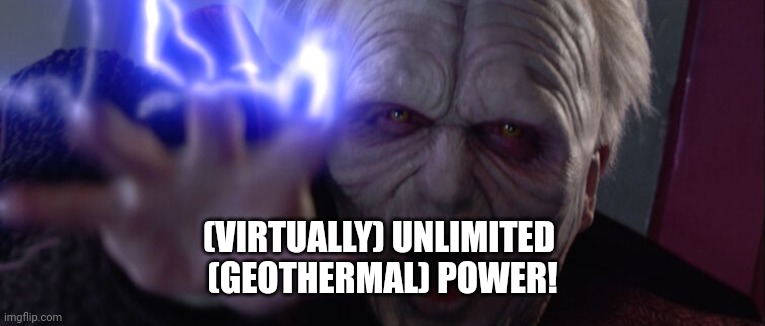- cross-posted to:
- environment@beehaw.org
- cross-posted to:
- environment@beehaw.org
Sounds like an idea in a film that doesnt end very well
It’s 2023. Every possible scientific venture has been the subject of a science fiction/horror movie.
The recycled steel in a kid’s braces was exposed to radiation, now she’s “The Thing With X-Ray Teeth!!”
We’re in 2024 now my guy
We are. He’s still working on it, and that’s okay.
Don’t pick on the late bloomer.
Just don’t drop the lightsaber perfectly vertical
Hmm, I wonder how much heat a lightsaber handle could take before it stops working.
Dangerous. Just one little block too much removed, then:
Apparently magma chambers have accidentally been drilled into before.
Edit: That’s actually in this article, too.
One of my favorites, as a kid. The title in the poster makes me laugh, reading that today.
You may find that getting your cautionary tales from a bunch of old, established powers might be flawed if you think about for a bit.
deleted by creator
I’m pretty sure I’ve seen a movie with exactly this premise before, lol.
Crack in the world (1965)
Disaster zone: volcano in New York. An absolute gem.
Iceland gets the vast majority of its power from geothermal, but this is the first time they’re drilling into an active volcano.
It’ll be an interesting experiment, and hopefully will help bring even more clean energy possibilities to the world.
Well… First time on purpose
From the article:
But we know for sure it can be done because in 2009 a nearby Icelandic geothermal plant accidentally drilled into Krafla’s magma chamber. The incident revealed important insights about the liquid state and dynamic interactions of the magma, although the drill’s steel casings were obliterated in the process. On the bright side, this incursion also showed that exposing the magma chamber doesn’t cause volcanoes to erupt.
Best “on the bright side” I have ever read.
I love how it’s first “Oh, we had some great findings.” and only second “And no one died.”.
We get the vast majority from hydroelectric energy, since we have huge glacial rivers.
For now
Do you want balrogs? Cause that’s how you get balrogs
They delved too deep and greedily…
This foe is beyond any of you. Run!
Gorillaz - Fire coming out of a monkeys head https://youtu.be/LtQHIv2O8x0?si=U0xgfZdriTWAM6UF
There’s surprisingly little geothermal power being actively produced by the Earth via radioactive decay relative to the world energy consumption. There’s loads of stored energy, but not a lot of new “production”, nor transmission.
40-some terawatts, apparently. We use maybe 20, converting from Wikipedia’s 600EJ/year.
Based on that, it’s a viable source of energy, but not with much room to grow. The sun provides 3 orders of magnitude more to our planet.
At the normal average 4% energy production growth rate we have another 28 years until we use up all new geothermal energy produced in the Earth, assuming we would only build geothermal from today.
But at the current total world geothermal energy production of ~0.1TW, it’ll take 150 years to reach the 40TW at 4% growth rate.
It’ll still take like 750 years until we suck all the stored geothermal energy (which is like 5.5555 quadrillion TWh) dry every year at 4% growth rate, but still, it seems like another “climate-change-like” moment to literally suck up all heat the heat being conducted to the surface of the planet from the interior.
Especially since we would differentially cool the crust, seems like a recipe for earthquakes and general troubles if we take it too far in the next hundred years or so.
We should generally aim to keep the net energy balance of the Earth the same as it was before we were here. If there is growth it has to happen in space or any heat production has to at least be beamed into space via the infrared atmospheric window (where it mostly passes through our atmosphere without being radiated back via the greenhouse effect).
So we should probably use geothermal energy very wisely.
4% per annum bites really fast, I don’t know if people realise that it has the same math as compound interest, it just seems slow if you’re looking at units smaller than decades. If we double our use every 30 years like you said, we’re also going to start having a sunlight shortage in 300 years. We could start using fusion then, but we shouldn’t, because the waste heat would start to cook us, and would be enough to boil off the ocean in roughly another hundred years of growth.
What actually has to happen, is that we pick all the low hanging fruit as far as infrastructure goes, and growth just slows. From a market perspective that probably means returns will get smaller and smaller, making things that were once too expensive to be practical the new best option for investors.
but still, it seems like another “climate-change-like” moment to literally suck up all heat the heat being conducted to the surface of the planet from the interior.
No joke! And, if we wanted, we could go even deeper once the upper layers are cool, since drilling would become easier. I’d guess we’d see less earthquakes, because enough heat removed would shut down plate tectonics entirely, turning Earth geologically into Mars. Deep sea vents might turn off. Probably other bad stuff would happen, but I don’t know what exactly.
So we should probably use geothermal energy very wisely.
Nothing could go wrong creating a volcano lair. /s
I wouldn’t be in their place when the Horned Reaper crawls out.
This is Iceland, it’s Surtr we need to worry abour
I don’t know. If Richard Ridings’ voice rings out when they emerge, I’d be torn.
I can’t seem to post an image, but here’s a meme I made: https://imgflip.com/i/8br6bg
Thank you, I love it.

There you go
Post a link with an ! before it. Example:
You can also post videos this way, by hosting on other websites such as mastodon.
I really like that image, very satisfying for some reason.
(it’s the symmetry)
Based, icland could get the biggest exporter of green Hydrogen doing that
I’ve seen this episode of Stargate, the entire planet became uninhabitable for centuries.
At least it’s not the Nazi planet episode.
Which one? Lol.
Didn’t just recently a volcano tunnel into Iceland? How safe is this?
Iceland has 32 active volcanoes. Eruptions are fairly routine, there.
I’m not saying this is safe or not. I’m just saying if any country in the world can tame a volcano, it Iceland.
32 volcanoes, but how many of them are over a mile long? That’s rad af.
Anyway, I wonder if drilling into the magma chamber won’t create a “path of least resistance” for when the volcano finally decides to erupt… doesn’t sound like a good idea to stay at the other end of such path.
Then, with earthquakes and what not, how stable can they keep that bore hole?
Now we just need to relocate the population.
deleted by creator
The power of the
sunearth, in the palm of my hands















